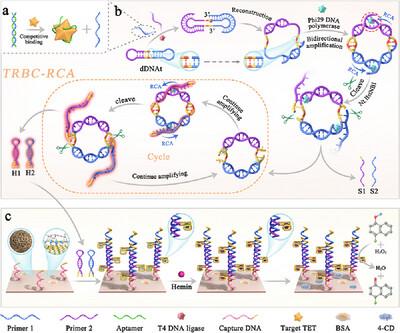用于级联放大-增强光电化学传感的工程原子精确钴电荷转移桥
IF 19
1区 材料科学
Q1 CHEMISTRY, MULTIDISCIPLINARY
引用次数: 0
摘要
单原子材料(SAMs)具有独特的电子结构和不饱和配位环境,具有最高的原子利用效率和优异的反应性,因此提供了一种先进的原子水平策略来减轻严重影响光电化学(PEC)响应的缓慢电荷转移动力学。本文利用钴单原子构建N─Co─O电荷转移桥(称为Co- actb),促进ZnIn2S4和MIL-125- nh2 (ZIS/MIL) Z-scheme异质结中的电荷分离。同步辐射x射线吸收光谱通过阐明Co的原子构型和局部配位特征,提示Co- actb的成功构建。理论计算表明,N─Co─O构型的电荷耗尽和电荷积累区共存,证实了它们是有效的电荷转移通道。Co-ACTB能明显增强电荷转移,提高光电性能。因此,ZIS/Co/MIL的峰值光电流为- 349.85µa cm - 2,比ZIS/MIL和ZIS分别提高9.6倍和162.7倍。此外,将模板重建介导的双向级联滚动圆放大策略与基于co - actb的光电极集成在一起,提供了一个灵敏的PEC传感平台,其线性响应范围为0.1 fM至10 nm,检测限为0.34 fM。这项工作为利用sam增强异质结内载流子分离,从而提高PEC传感性能提供了新的见解。本文章由计算机程序翻译,如有差异,请以英文原文为准。

Engineering Atomically Precise Cobalt Charge-Transfer Bridges for Cascade Amplification-Enhanced Photoelectrochemical Sensing
Single-atom materials (SAMs), which are characterized by unique electronic structures and unsaturated coordination environments, exhibit maximum atomic utilization efficiency and exceptional reactivity, thus offering an advanced atomic-level strategy to mitigate sluggish charge transfer kinetics that severely affect photoelectrochemical (PEC) responses. Herein, a cobalt single atom is employed to construct N─Co─O charge transfer bridges (termed Co-ACTB) to facilitate charge separation in ZnIn2S4 and MIL-125-NH2 (ZIS/MIL) Z-scheme heterojunctions. Synchrotron radiation X-ray absorption spectroscopy suggests the successful construction of Co-ACTB by elucidating the atomic configuration and local coordination characteristics of Co species. Theoretical calculations reveal coexisting regions of charge depletion and accumulation enveloping N─Co─O configuration, confirming their function as effective charge-transfer channels. Co-ACTB obviously strengthen charge transfer and enhance photoelectric properties. Consequently, ZIS/Co/MIL achieves a peak photocurrent of −349.85 µA cm−2, representing 9.6-fold and 162.7-fold enhancements over those of ZIS/MIL and ZIS, respectively. Furthermore, a template reconstruction-mediated bidirectional cascade rolling circle amplification strategy is integrated with a Co-ACTB-based photoelectrode to afford a sensitive PEC sensing platform, exhibiting a linear response ranging from 0.1 fM to 10 nm with a detection limit of 0.34 fM. This work provides novel insights into utilization of SAMs to enhance carrier separation within heterojunctions, thereby enhancing PEC sensing performance.
求助全文
通过发布文献求助,成功后即可免费获取论文全文。
去求助
来源期刊

Advanced Functional Materials
工程技术-材料科学:综合
CiteScore
29.50
自引率
4.20%
发文量
2086
审稿时长
2.1 months
期刊介绍:
Firmly established as a top-tier materials science journal, Advanced Functional Materials reports breakthrough research in all aspects of materials science, including nanotechnology, chemistry, physics, and biology every week.
Advanced Functional Materials is known for its rapid and fair peer review, quality content, and high impact, making it the first choice of the international materials science community.
 求助内容:
求助内容: 应助结果提醒方式:
应助结果提醒方式:


